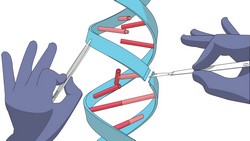Structural analysis of DNA repair proteins
Chemotherapy, the gold standard of cancer treatment, utilises drugs that cause DNA damage and hence cell death. However, cells utilise mechanisms such as nucleotide excision repair to rectify DNA damage and maintain genomic integrity. During this process, the structure-specific XPF/ERCC1 endonuclease cleaves double-stranded to single-stranded DNA junctions, thereby repairing the DNA cross-links induced by the platinum drugs. Evidence suggests that reducing XPF/ERCC1 activity could sensitise cancer cells to chemotherapeutic drugs, improving their efficiency. However, the identification of XPF/ERCC1 inhibitors for anti-cancer therapy has proven difficult. To aid in the development of such pharmacological agents, the EU-funded XPF-ERCC1 (Structural and kinetic studies of XPF/ERCC1-DNA complex for drug discovery) project set out to investigate the mechanism by which XPF/ERCC1 recognises and cleaves DNA targets. Researchers employed a combination of structural and kinetic methods to study the recognition of the relevant DNA substrates by the XPF/ERCC1 protein. NMR methodology was used to obtain a structural model of the XPF/ERCC1-DNA complex at the atomic level, while kinetic measurements allowed scientists to delineate the binding/dissociation rates. A minimal heterodimer of the full-length protein that cleaved all DNA structures was successfully expressed and purified for crystallographic and enzymatic studies. Next, the minimal XPF/ERCC1 protein was placed under optimised conditions in a high-throughput screen for inhibitors of nuclease activity. Several promising leads were identified that were further investigated. Researchers discovered that the affinity of the XPF/ERCC1 protein for different substrates did not differ significantly, but they affected complex stability. Overall, the project made significant progress regarding the solubility and aggregation of the XPF/ERCC1 protein, the characterisation of the affinity to different DNA substrates and stability of the relevant protein-DNA complexes. This information will pave the way for future studies on delineating the correlation between DNA binding and enzymatic activities of the XPF/ERCC1 protein.







